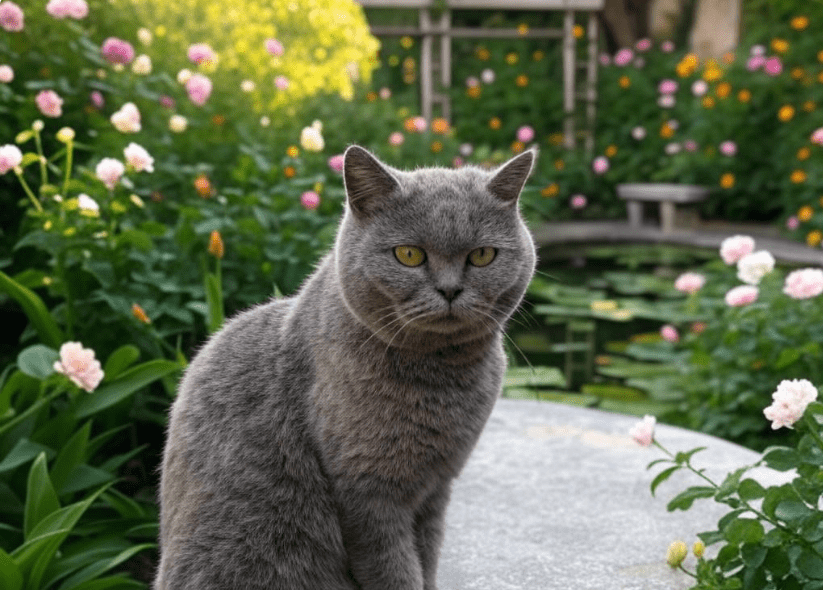
British Shorthairs, with their plush coats and calm demeanor, are cherished companions, but nail trimming for British Shorthairs is an essential part of their grooming routine to ensure their comfort and your home’s safety. Their sturdy, round paws house sharp claws that can grow too long, causing discomfort, scratching, or damage to furniture. Regular nail trimming keeps your British Shorthair healthy and happy while preventing unwanted scratching. This comprehensive guide provides a step-by-step approach to nail trimming for British Shorthairs, including tools, techniques, and tips to make the process stress-free for both you and your cat.
Why Nail Trimming for British Shorthairs Is Important
The British Shorthair’s claws, like those of all cats, grow continuously and can become overgrown without regular maintenance. Proper nail trimming for British Shorthairs offers several benefits:
Prevents Discomfort: Overgrown nails can curl into the paw pads, causing pain or infections, which affect up to 10% of cats with neglected claws.
Reduces Scratching Damage: Trimmed nails minimize damage to furniture, carpets, and skin during play or cuddling.
Improves Mobility: Long nails can alter a cat’s gait, leading to joint strain, especially in the stocky British Shorthair breed.
Prevents Nail Splitting: Overgrown or jagged nails may split, causing pain and requiring veterinary attention.
Enhances Bonding: Gentle nail trimming builds trust, strengthening your relationship with your British Shorthair.
By incorporating nail trimming for British Shorthairs into your grooming routine, you’ll promote your cat’s well-being and maintain a scratch-free home.
How Often Should You Trim Your British Shorthair’s Nails?
The frequency of nail trimming depends on your British Shorthair’s lifestyle and nail growth rate:
General Recommendation: Trim nails every 2–3 weeks to keep them at a safe length.
Indoor Cats: Indoor British Shorthairs may need trimming every 2 weeks, as they have fewer opportunities to wear down claws naturally.
Active or Outdoor Cats: Cats with access to scratching posts or outdoor surfaces may need trimming every 3–4 weeks.
Senior Cats: Older British Shorthairs may require more frequent trimming (every 1–2 weeks) due to reduced activity and slower claw shedding.
Check your cat’s nails weekly by gently pressing their paw to extend the claws. If the nails extend beyond the paw pad or feel sharp, it’s time to trim.
Tools and Supplies for Nail Trimming

To perform nail trimming for British Shorthairs safely and effectively, gather these supplies:
Cat Nail Clippers: Choose scissor-style or guillotine-style clippers, such as Pet Republique Cat Nail Clippers or Safari Professional Nail Trimmer, designed for precision and safety.
Styptic Powder: Products like Kwik Stop Styptic Powder stop bleeding if you accidentally cut the quick (the pink blood vessel in the nail).
Towel or Blanket: Wrap your British Shorthair in a towel to keep them secure and calm, especially for beginners.
Treats: High-value treats, like Temptations Cat Treats or freeze-dried salmon, reward your cat and create positive associations.
Flashlight: A small flashlight helps you see the quick in darker nails, reducing the risk of cutting it.
Grooming Gloves (Optional): Gloves like PetThunder Grooming Gloves protect your hands if your cat is prone to scratching.
Store supplies in a clean, accessible kit to streamline your nail trimming for British Shorthairs routine. Ensure clippers are sharp and sanitized before use to prevent nail splitting or infections.
Step-by-Step Guide to Nail Trimming for British Shorthairs
Follow these steps to trim your British Shorthair’s nails safely and without stress:
Step 1: Prepare Your Cat and Environment
Choose a Calm Time: Trim nails when your British Shorthair is relaxed, such as after a meal or nap. Avoid high-energy moments like playtime.
Set Up a Comfortable Space: Use a table or counter with a non-slip surface, covered with a towel for comfort. Have all supplies within reach.
Introduce Tools Gradually: Let your cat sniff the clippers and offer a treat to reduce anxiety. Rub their paws gently to familiarize them with handling.
Position Your Cat: Sit your British Shorthair on your lap, facing away from you, or wrap them loosely in a towel, leaving one paw accessible. For solo trimming, a helper can hold your cat gently.
Step 2: Inspect the Nails
Extend the Claws: Gently press the paw pad to extend the claws. Use a flashlight to locate the quick, which appears pink in light-colored nails but is harder to see in dark ones.
Check for Issues: Look for split, overgrown, or ingrown nails. If nails are curling into the paw pad or appear infected, consult a vet before trimming.
Start with Front Paws: British Shorthairs typically have five claws on each front paw and four on each back paw. Focus on front paws first, as they’re used more for scratching.
Step 3: Trim the Nails
Hold the Paw Firmly: Grasp the paw gently but securely, keeping your cat steady. If they pull away, pause and offer a treat before continuing.
Clip the White Tip: Position the clippers to cut only the white, translucent tip of the nail, about 1–2 mm from the quick. Angle the clippers at 45 degrees for a clean cut.
Trim One Nail at a Time: Work slowly, trimming one nail and releasing the paw if your cat seems restless. Aim to trim 2–3 nails per session for nervous cats.
Avoid the Quick: Cutting the quick causes pain and bleeding. If you’re unsure, trim less and check with a vet or groomer for guidance.
Check Back Paws: Back claws grow more slowly and may need less frequent trimming, but inspect them regularly.
Step 4: Handle Accidents
Stop Bleeding: If you cut the quick, apply styptic powder or cornstarch to the nail and press gently for 30 seconds to stop bleeding. Comfort your cat and pause trimming.
Monitor for Pain: Watch for limping or paw sensitivity over the next few hours. If bleeding persists or your cat seems distressed, contact a vet.
Step 5: Reward and Release
Offer Treats and Praise: Immediately reward your British Shorthair with treats and gentle praise to reinforce positive behavior.
Let Them Relax: Allow your cat to groom or stretch, as this is a natural response to nail trimming.
Check Behavior: Observe for excessive licking or paw favoring, which may indicate discomfort or a need for veterinary attention.
Step 6: Clean Up
Dispose of Nail Clippings: Collect clippings in a bag to prevent them from scattering.
Sanitize Tools: Clean clippers with rubbing alcohol or soap and water to maintain hygiene.
Wash Your Hands: Remove fur or debris and wash thoroughly to avoid allergens.
Tips to Reduce Stress During Nail Trimming

British Shorthairs are typically docile, but nail trimming can be unsettling. Use these strategies to make nail trimming for British Shorthairs stress-free:
Start Young: Introduce paw handling to kittens, gently pressing their pads to extend claws and rewarding with treats. This builds tolerance for trimming.
Go Slow: For nervous cats, trim one or two nails per session over several days to avoid overwhelming them.
Use Calming Aids: Products like Feliway Classic Spray or calming treats can reduce anxiety. Spray Feliway on the towel 15 minutes before trimming.
Play Soothing Sounds: Soft classical music or white noise can calm your cat, as suggested by feline behaviorists.
Know When to Stop: If your British Shorthair becomes aggressive or stressed, pause and try again later to avoid damaging trust.
Involve a Professional: If your cat consistently resists, ask a vet or groomer to trim nails or demonstrate techniques. Professional grooming costs $20–$50 per session.
Common Mistakes to Avoid When Trimming British Shorthair Nails
To ensure safety and effectiveness, steer clear of these pitfalls:
Cutting the Quick: Always trim only the white tip to avoid pain and bleeding. Use a flashlight to locate the quick in dark nails.
Using Dull Clippers: Dull blades can split nails, causing discomfort. Replace or sharpen clippers regularly.
Rushing the Process: Hurrying can stress your cat and lead to mistakes. Take your time, even if it means multiple short sessions.
Ignoring Paw Health: Check for ingrown nails, infections, or sores before trimming. Avoid trimming if you notice abnormalities and consult a vet.
Forcing Your Cat: Restraining an agitated cat can lead to scratches or distrust. Pause and use calming techniques instead.
Neglecting Back Paws: Back claws may grow slower but can still cause issues if left untrimmed.
Recognizing Nail and Paw Problems in British Shorthairs

Regular nail trimming for British Shorthairs helps you monitor paw health. Watch for these signs of potential issues:
Ingrown Nails: Nails curling into the paw pad cause pain, swelling, or infection. Common in senior or less active cats.
Split or Brittle Nails: May result from trauma, poor diet, or fungal infections. A vet can recommend supplements or treatments.
Paw Pad Injuries: Cuts, burns, or foreign objects (e.g., thorns) can cause limping or sensitivity. Clean minor wounds with antiseptic and seek vet care for deep injuries.
Infections: Red, swollen, or smelly paws may indicate bacterial or fungal infections, often requiring antibiotics or medicated ointments.
Allergies: Itchy paws or excessive licking may signal allergies, especially in British Shorthairs prone to skin sensitivities.
If you notice any of these symptoms, stop trimming and contact your veterinarian. Diagnostic tests, such as skin scrapings or cultures, may be needed to identify the cause.
When to Seek Veterinary Help
While routine nail trimming for British Shorthairs is safe for healthy cats, professional care is needed in these cases:
Ingrown or Infected Nails: A vet can safely remove ingrown nails and prescribe antibiotics for infections.
Persistent Bleeding: If bleeding doesn’t stop after applying styptic powder, a vet can assess for clotting issues or deeper cuts.
Chronic Paw Issues: Recurring swelling, limping, or nail problems may indicate allergies, arthritis, or systemic conditions requiring blood work or imaging.
Behavioral Resistance: Cats that consistently fight trimming may benefit from sedation or professional grooming to avoid injury.
First-Time Trimming: If you’re unsure about trimming, ask your vet for a demonstration to build confidence.
Veterinary visits for nail or paw issues typically cost $50–$200, depending on diagnostics or treatments. Early intervention prevents complications and keeps your cat comfortable.
Preventive Care for Healthy British Shorthair Nails
In addition to regular trimming, these habits support nail trimming for British Shorthairs and overall paw health:
Provide Scratching Posts: Offer sturdy scratching posts, like the SmartCat Ultimate Scratching Post, to naturally wear down claws and reduce trimming frequency.
Monitor Diet: A balanced diet with biotin, zinc, and omega fatty acids supports strong nails. Brands like Royal Canin British Shorthair are breed-specific.
Keep Paws Clean: Wipe paws with a damp cloth after outdoor play to remove dirt or irritants, especially for outdoor British Shorthairs.
Check Paws Regularly: Inspect paws weekly for cuts, swelling, or foreign objects, especially in active cats.
Maintain Indoor Safety: Keep floors free of sharp objects that could damage paws, and use pet-safe cleaning products to avoid irritation.
Conclusion

Mastering nail trimming for British Shorthairs is a vital skill for every owner of these charming, plush-coated cats. With the right tools, a gentle approach, and a stress-free routine, you can keep your British Shorthair’s nails at a safe length, preventing discomfort and protecting your home from scratches. This guide’s step-by-step instructions, from preparation to post-trimming care, empower you to perform nail trimming for British Shorthairs confidently while avoiding common mistakes.
Invest in quality clippers like Pet Republique Cat Nail Clippers, use calming techniques, and monitor paw health regularly. If you encounter resistance or nail issues, consult a veterinarian or professional groomer for personalized advice. With consistent nail trimming for British Shorthairs, your cat will enjoy healthy paws and a stronger bond with you.



